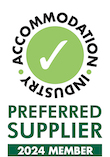Five Unique Ways to Set Your Table
“Every restaurant needs to have a point of view.” Danny Meyer.
And what better point of view than a set table ready for people to enjoy a meal?
As a restaurant owner, finding new ways to set tables is a challenge you have to deal with every day, so it calls for creativity.
The style of table setting you choose sends a message to your guests.
It tells them whether it’s a business dinner, wedding reception or cocktail party.
But how do you set tables?
There are rules to follow. Here are some of the lesser-known ones that will make your restaurant stand out.
Let’s count down, shall we?
5. Use Mismatched Colour Themes
Many people believe the only way to set a table is to use matching sets of silverware. But this is so overrated. It’s boring to set an entire table with the same pieces.
Be creative. Silverware is much more than crockery.
Psychologists say the colour and shape of plates and other dishes have an impact on one’s dining experience. For example, people tend to eat less when their dishes are in sharp colour contrast to their food.
Set your restaurant apart by using mismatched silverware. Mix up a modern tablescape with vintage silverware. It will bring character to your restaurant and add colour.
It is also bound to leave your guests intrigued.
4. Place Silverware on Unique Surfaces
Instead of placing cutlery on the table, use a slab of stone. Put the slab on the left side of the charger and place your knives and forks on it.
Guests can place cutlery on the slabs between different meals. This makes it easy for the restaurant’s staff to wipe spills instead of removing the entire table decor.
If the setting is for a casual event, opt for a wicker cutlery basket. This is different from the conventional way of putting your cutlery on a table.
Use a colourful napkin to wrap cutlery then place it in the wicker basket. It will brighten the dining table.

|

|
3. Always Use a Service Tray
Table setting can be stressful, but having a system in place makes it less of a chore. It also keeps mealtime more orderly.
Using a serving tray to carry cutlery is more efficient. It keeps germs at bay and makes a good impression on your guests.
As you move glasses from the tray to the table, do not pick them by the bowl. Always hold them at the stem or base.
If you must carry a plate, place it in the palm of your hand. Don’t let your fingers touch the rim of the plates
Once your guests have finished eating, clear the table. There are three rules you must follow:
-
Clear plates from the right-hand side of your guests. Use the right hand to pick up plates and the left hand to stack the cleared plates.
You will know guests have completed eating if they leave silverware crossed on the plate. Another sign is if there is very little food left on the plate and the guests sit back with folded hands.
- Clear the largest items from the table first as you work your way towards the smallest items. Always start with the plates and finish with the silverware.
Avoid clearing utensils by holding their eating surfaces. Instead, hold the bottom. This protects you from the guests’ germs.
2. Don’t Use Overpowering Centrepieces
Centrepieces are the focus of a table, but they shouldn't overwhelm the setting.
When you have large tables, you can place many centrepieces on the table linen. Try to leave enough space on the table for items like salt, pepper shakers and breadbaskets.
If your centrepieces are flowers, pick a subtle scent. You don’t want them to overpower the food with their fragrance. Also, be careful not to aggravate guests who have flower allergies.
Consider the height of your centrepieces. They need to be low enough for guests to see each other across the table.
The safety of your guests is important. Place centrepieces away from the table edges. It will prevent any accidents if the table is bumped, especially if the pieces are candles or vases.
1. Consider the Different Settings
Depending on the occasion, different rules of table setting will apply. Consider these four common settings
- Formal
- Informal
- Basic
- Buffet
a) Formal Setting
If you are aiming for a formal setting, such as a business dinner, click the image below to view the steps to follow:
 Image: etiquettescholar
Image: etiquettescholar
b) Informal Setting
There are fewer utensils used in an informal setting compared to a formal one. An example of informal settings includes a cocktail party.
The following rules apply
- The dinner plate should have a napkin folded on it.
- On the right-hand side of the plate, place the dinner knife with the blade facing inwards.
- Next to the knife, place the dessert spoon. You can bring the dessert spoon after the meal because it is used last.
- The soup spoon goes next to the dessert spoon.
- Place the forks on the left of the plate. The salad fork goes to the far left while the dinner fork sits between the salad fork and dinner plate.
- The salad plate goes to the left of the forks.
- All glasses go to the right of the plate. These include water, juice or wine glasses.
c) Basic Setting
This is a simplified version of an informal setting with a few differences. For example, instead of using a salad and dinner plate, guests serve the salad on their dinner plates.
Brunch or casual family dinners are examples of a basic setting.
Here is how to set the table.
 Image: hugohd
Image: hugohd
d) Buffet Setting
Buffet settings offer an opportunity for self-service. Guests get to select the kind of food they want to eat and in what quantity.
These are the rules to follow when setting a buffet table.
- Always begin with plates. At most, stack 12 plates together.
- Place napkins between each plate in the stack to save on space.
- Next to the plate, place side dishes, main dishes, vegetables and salads, in that order.
- Place the table decorations at the centre of the buffet table.
- To avoid congestion, have a different table where you set desert.
General Table Setting Rules
There are a few general rules that apply to these types of table settings: basic, formal and informal.
Placements. Place all the utensils about an inch from the edge of the table.
Forks. These go on the left side of the main service plate. The dessert fork is an exception. Place it above the plate.
Knives. Always place knives on the right side of the plate. Ensure the cutting blade faces inwards towards the plate. The butter knife is an exception. Place it on the butter plate with the blade pointing downwards and left.
Spoons. Place spoons on the right side of the plate. The dessert spoon is an exception. Place it above the service plate.
Placement. All utensils should be about an inch from the edge of the table.
Set only what you use. Only set the utensils in use throughout the service. If there is no soup, there’s no need to set a soup spoon.
Now that you know how to set your tables, give your guest a memorable experience.
Remember, for food and beverage linen, head over to Australian Linen Supply now.
You’ll love their superior quality and pocket-friendly prices.
Feature Image: Tama66















